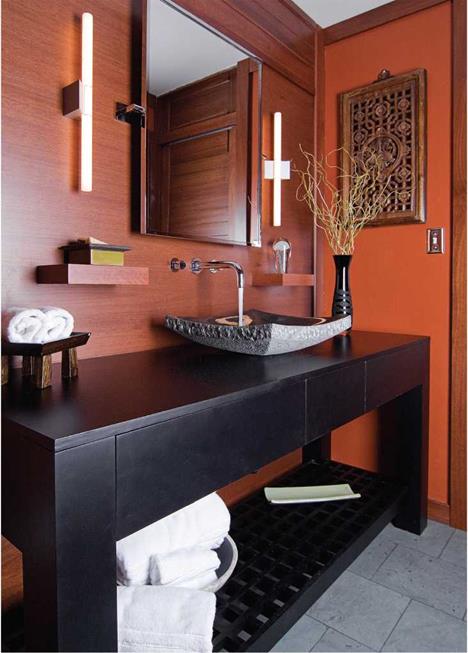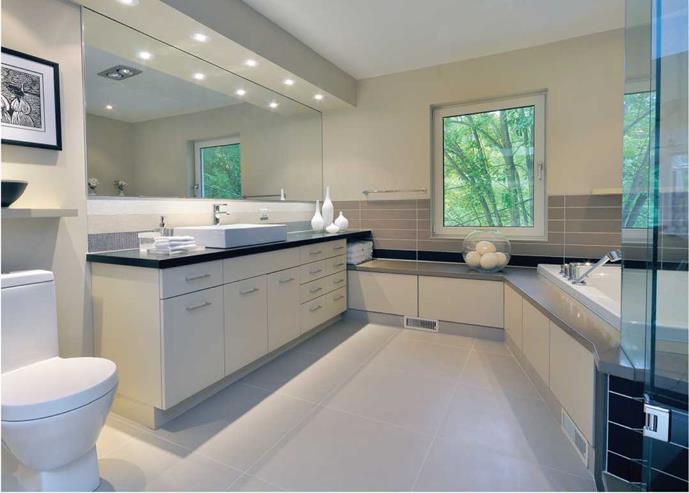• Multiple generations. For many cultures, one home may accommodate many generations. Therefore, designers may need to plan spaces that will accommodate this multigenerational family. This typically means more bathrooms and perhaps separate suites with a private bath.
• Folk and ethnic patterns. Designers are using more folk – and ethnic-inspired patterns in their bathrooms. Incorporating hand-sewn trims on towels and the use of birds and flowers in accessories help create what they call the “folkloric" look.
fixtures
• Luxury bathrooms. Despite the fact that some people are cutting out some of the extravagant features in their bathroom, people still enjoy space and luxury if they can afford it. In today’s luxury bathrooms, fixtures make a statement. They can dominate, through the use of large tubs and massive stone pieces, or they can present a softened look by using sculptured fixtures with delicate lines.
• Lavatory choices. New trends are emerging in fixture design. The undermount lavatory dominates newly remodeled bathrooms with the vessel or bowl lavatory as a clear second. These vessels, which can be made of many different types of materials, often sit on a flat, wall-hung base with plumbing exposed below, but can be placed on a vanity cabinet as well. Counter – and wall-mounted spouts and controls are commonly used with these fixtures. Integrated, pedestal and drop-in lavatories are still popular, but were specified less often by designers.

Reevaluating the jetted tub. In the past number of years, more households are finding that they are not using their large whirlpool or jetted tubs, once a must in most luxury master baths. Designers report that if jetted tubs are incorporated they are becoming more therapeutic with gentler hydrotherapy bubbles, as well as integral support, lighting, sound, and scents to provide more of the spa experience.
Freestanding tubs. Whether jetted or just used for soaking, large tubs that are incorporated into larger master baths are freestanding and take a central and prominent place in the room. The tub’s styling may be rounded or angled, depending on the styling of the room.
Fewer tubs. Whether remodeling or designing a new home, a trend among more homeowners is to install only showers in most of the home’s bathrooms and perhaps have a standard tub in only one location. In general, households are using showers instead of tubs and many times a shower can be installed in a smaller space and perhaps at less expense. At least one tub may be needed in the home, however, for bathing children and for those who prefer tub bathing.
Large, open showers. Although some homeowners are hanging onto tubs to preserve resale value, others are eliminating the tub altogether in the master bath and replacing it with a large shower stall, especially where space is limited and the room cannot accommodate both. For daily uses, the shower is becoming the preferred method of bathing instead of a tub for that quick morning getaway. These larger showers are often designed to accommodate more than one person and have a surround enclosure design with an open entrance (see Figure 1.24). Steam, lights, multiple showerheads and body sprays (see Figure 1.25), rain shower – heads, aromatherapy, chromatherapy, and music are also becoming part of the showering experience.
|
FIGURE 1.22 The contemporary style with its simple lines is displayed here in the increasingly popular gray hues. Design by NKBA member: Jan E. Regis, |
• Universal design. Universal design considerations are incorporated into bathroom fixture selec – CMKBD tion and placement. Vanities with knee space, single-lever plumbing fixtures, hand spray fixtures, comfort-height toilets, larger showers with illuminated thresholds and doors or a zero
entry shower, eliminating the threshold all make the bathroom a place that accommodates everyone’s needs. Grab bars no longer look institutional, and tubs have doors and soft, contoured seats. More information on universal design is included in chapter 4.
• Faucet finishes. The most popular finish for faucets in 2010 was satin nickel, with brushed nickel also being a favorite. Other popular faucet finishes are bronze and oil-rubbed bronze, polished chrome, and polished nickel.
• White fixtures dominate. The most common color of bathroom fixture is white. Bisque and off-white were used in far fewer projects by designers.
• Countertops. Quartz is gaining ground on granite as a popular bathroom vanity top material, but granite still dominates the market.
• Tile still trendy. Ceramic and porcelain tiles on the floor continue to dominate the projects with natural stone also proving to be popular. Variations of inlay floors are also appearing, especially in many traditional themes like those that carry a French chateau feel. Faux hardwood porcelain tiles shaped in planks give the hardwood look to the floor without actually using wood, which can be easily damaged by moisture, a major concern in a bathroom.
• New tile trends. Nontraditional materials are showing up in tiles for the bathroom including copper, bronze, stainless steel, and glass. Glass tiles, in particular, are being incorporated into
|

floors, backsplashes, and shower walls to create a luxury spa-like atmosphere. Many of the glass tiles are made from recycled glass. Designers are incorporating textured metallic floor and wall tiles that incorporate what they see as a "Russian" influence. The newer 3D wall tiles add texture to rooms.
• Natural materials. A prevalent design element is the use of natural materials. The natural or organic feel includes the use of wooden bathtubs and sinks, and rich wood grains in cabinetry. In places where water is a concern, the "wood look" tiles may be used, and they even come in "log cut" styles for the log cabin feel. New waterproof wood coverings can be used for floors or walls to create that nature-inspired room. The use of natural stone (see Figure 1.26) adds to the earthy look, but porcelain tiles laser printed with natural stone patterns are also emerging, having the added benefits of scratch resistance, durability, suitability to wet areas, cost efficiency, and no need of sealing.




